To determine if your property is asbestos-free, professional testing is essential. Asbestos exposure poses serious health risks, including lung cancer and asbestosis. Certified inspectors conduct thorough surveys, collecting samples from high-risk areas and using advanced lab analyses like Polarized Light Microscopy. There are two main types of surveys: Management Surveys for ongoing occupancy and Refurbishment or Demolition Surveys before renovations. Proper testing helps you identify any asbestos-containing materials, ensuring compliance with safety regulations. For homeowners, understanding the testing process is critical for safeguarding your property. Learn more about the next steps you can take to protect your space further.
Importance of Asbestos Testing
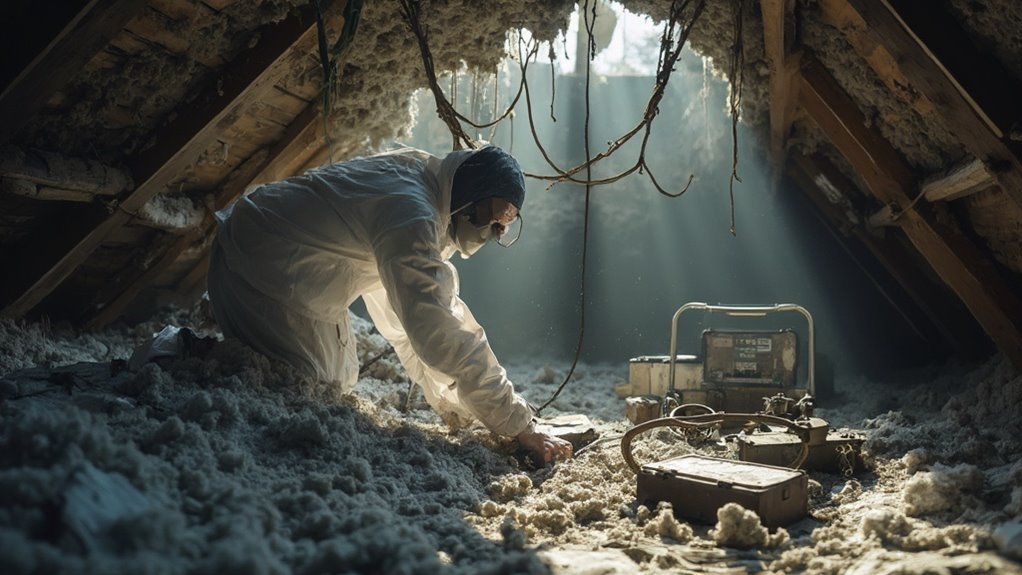
Asbestos testing is indispensable for protecting both your health and property, especially in older buildings where asbestos-containing materials may be present. The health risks associated with asbestos exposure are severe, leading to diseases such as asbestosis, lung cancer, and mesothelioma. Since there's no safe level of exposure, even minimal contact can pose risks, highlighting the need for regular testing. Asbestos is a group of naturally occurring fibrous minerals known for their heat resistance, tensile strength, and insulating properties. Understanding federal and state regulations is crucial for responsible asbestos management and ensuring compliance with safety standards.
Asbestos regulations play an important role in guaranteeing that properties comply with safety standards. Many jurisdictions mandate testing before any renovation or demolition work. Following these regulations isn't just a legal obligation; it's a significant component of due diligence that protects everyone involved. Failure to adhere can result in substantial legal and financial penalties.
Testing frequency is pivotal, particularly for properties undergoing renovation or those that have undergone previous construction. Regular assessments help identify any new risks and guarantee that any potential hazards are managed effectively. By prioritizing asbestos testing, you not only comply with regulations but additionally protect your health and that of others. Engaging professional services for thorough testing and assessment can provide peace of mind and aid in making well-informed choices regarding your property.
Understanding the Testing Process
How do you guarantee a thorough understanding of the asbestos testing process? By familiarizing yourself with the detailed testing procedures that professionals follow. Initially, samples are collected from various areas of your property, particularly targeting potential "hot spots" like insulation, tiles, and popcorn ceilings. A well-structured survey plan outlines the sampling strategy, securing extensive coverage. During sample collection, protective gear and handheld equipment minimize exposure, and each sample is meticulously labeled for identification.
Once collected, these samples undergo laboratory analysis using advanced techniques such as Polarized Light Microscopy (PLM) and Transmission Electron Microscopy (TEM). PLM identifies asbestos based on its optical properties, while TEM examines finer fibers for chemical composition. Initial assessments may likewise involve stereomicroscopy.
After analysis, a detailed report is generated, outlining the locations tested, types of asbestos found, and associated risks. This report may include visual aids to improve understanding. Additionally, understanding the asbestos management plan is crucial for long-term safety and compliance.
Lastly, sample handling extends beyond testing; samples are double-bagged and stored for six months, following strict protocols to prevent contamination. Proper disposal by registered firms guarantees safety, maintaining detailed records throughout the process. Understanding these steps is vital for securing your property's safety.
Different Types of Testing
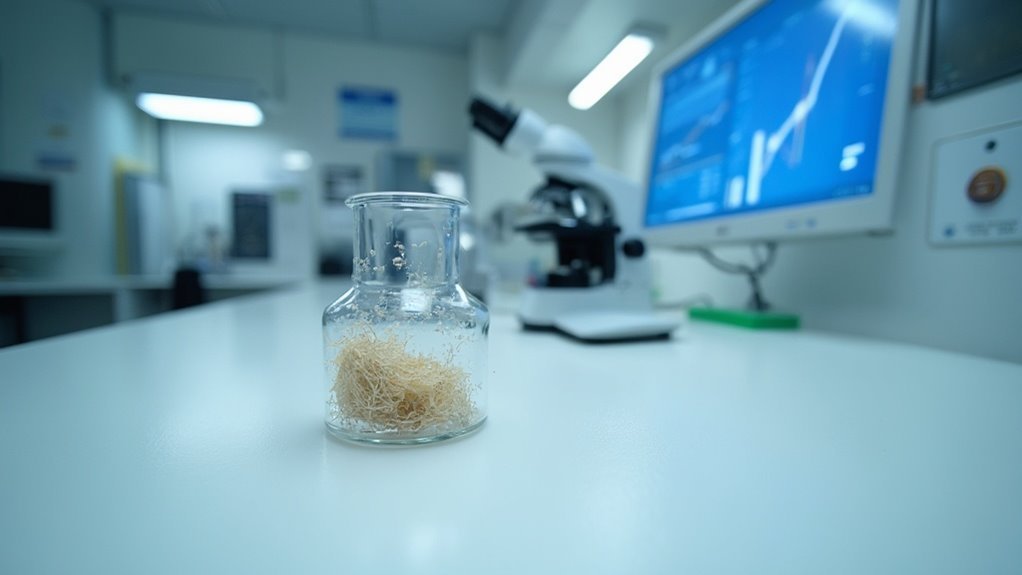
When testing for asbestos, you'll encounter various methods, including bulk sampling techniques and air quality assessments. Each approach has its specific applications and advantages in identifying the presence of asbestos. Understanding these laboratory analysis methods is essential for ensuring your property's safety and compliance.
Bulk Sampling Techniques
In the domain of asbestos testing, bulk sampling techniques play a vital role in accurately identifying the presence of asbestos in various materials. You'll typically encounter two main asbestos analysis techniques: Polarized Light Microscopy (PLM) and Transmission Electron Microscopy (TEM). PLM is suitable for bulk samples, while TEM is used for non-friable organically bound materials (NOBs).
Here's a quick overview of these techniques:
| Technique | Use Case |
|---|---|
| Polarized Light Microscopy (PLM) | Bulk samples, limited detection capabilities for low percentages of asbestos |
| Transmission Electron Microscopy (TEM) | Non-friable organically bound materials (NOBs), higher sensitivity |
| Sample Extraction | Material piece extracted for lab analysis |
| Layered Materials | Each layer must be sampled and analyzed separately |
| Laboratory Accreditation | Must be NVLAP accredited and ELAP certified |
When conducting bulk material sampling, be aware of AHERA's specifications regarding the number of samples required per homogeneous area. Remember, accurate and methodical sampling is critical to guarantee reliable asbestos analysis.
Air Quality Assessment
Air quality assessment is crucial for guaranteeing the safety of environments potentially contaminated by asbestos. Various testing methods provide insight into airborne contaminants, with two primary techniques being Phase Contrast Microscopy (PCM) and Transmission Electron Microscopy (TEM). PCM analyzes air samples collected on filters, identifying asbestos fibers based on size and shape, though it's less precise than TEM. TEM, on the other hand, employs electron microscopy to detect ultrafine asbestos fibers invisible to PCM, offering superior testing accuracy and the ability to differentiate between asbestos types.
Air sample collection involves using mechanical pumps to draw air through filters, typically over 1 to 8 hours. This duration depends on regulatory standards and the specific goals of the assessment. Proper calibration of air pumps before and after sampling guarantees accurate air volume measurement.
Different types of air quality testing include asbestos background air testing, clearance testing, and area air quality assessments. These assessments help monitor asbestos levels during and after remediation projects, guaranteeing safe environments. By utilizing these methods, you can effectively evaluate the presence of airborne asbestos and other contaminants, contributing to informed safety decisions.
Laboratory Analysis Methods
Laboratory analysis methods are critical for accurately identifying and quantifying asbestos in bulk materials. Various analytical techniques are employed to guarantee precision and reliability in results. Initially, stereomicroscopy helps identify fibers based on their physical properties. For more detailed analysis, Polarized Light Microscopy (PLM) uses refractive index liquids to specify asbestos types. Transmission Electron Microscopy (TEM) provides intricate fiber morphology insights, while Phase Contrast Microscopy (PCM) is fundamental for airborne fiber analysis. Fourier-Transform Infrared Spectroscopic Microscope (FTIR) likewise plays an important role in material analysis.
Sample handling is meticulous; analysts prepare samples within dust cabinets featuring negative pressure and HEPA filters, guaranteeing safety. Only qualified personnel, like those P401 certified, operate in UKAS accredited laboratories. Each sample undergoes thorough examination under various filters to assess properties such as color and pleochroism.
Furthermore, regulatory standards, including those from EPA and NIOSH, guide the laboratory processes. All stages of analysis are recorded in approved database systems, guaranteeing traceability. Proper sample storage and disposal by registered asbestos firms further emphasize the significance of adhering to stringent safety and regulatory guidelines in asbestos testing.
Professional Testing Services
Professional testing services for asbestos are essential for ensuring the safety and compliance of your property. You should rely on certified inspectors with NYS Asbestos Inspector and Tester certifications, backed by over 20 years of experience. They utilize advanced testing technologies, including Polarized Light Microscopy (PLM) and Transmission Electron Microscopy (TEM), to accurately identify asbestos in materials and air samples.
Many asbestos myths mislead property owners into underestimating the risks associated with exposure. Professional testing helps dispel these myths by providing reliable data. Inspectors meticulously collect samples from potential asbestos-containing materials and send them to accredited laboratories for thorough analysis. This rigorous process adheres to the Department of Health guidelines and EPA standards, ensuring regulatory compliance.
After testing, you receive detailed reports outlining the asbestos types and their concentrations, enabling well-informed choices regarding abatement. The involvement of professionals not only guarantees accurate results but also promotes extensive safety measures to prevent unnecessary exposure. By choosing professional testing services, you're investing in your property's safety and securing peace of mind for yourself and future occupants.
Types of Asbestos Surveys
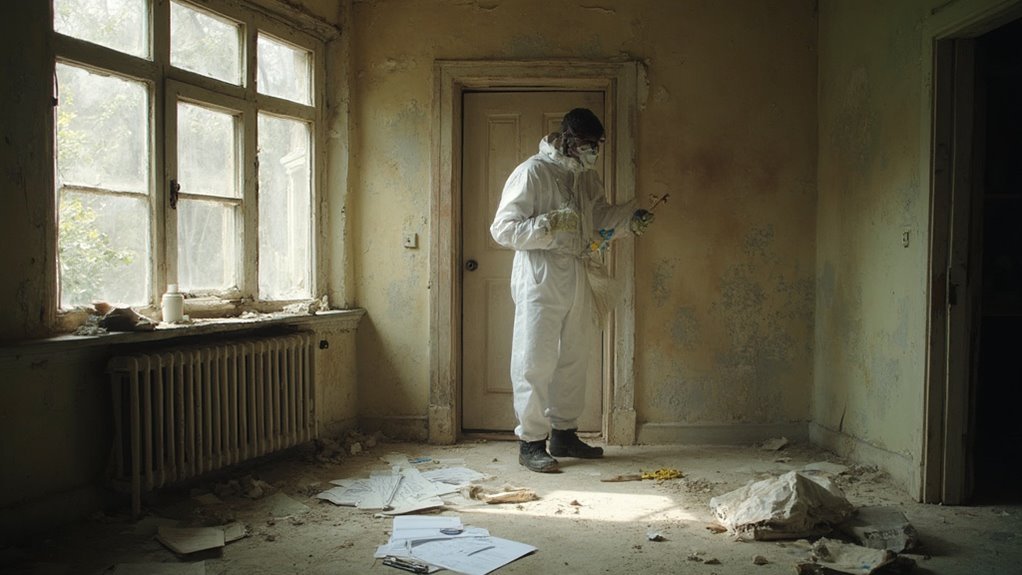
When evaluating your property for asbestos, it's vital to understand the two primary types of surveys: Management Surveys and Refurbishment/Demolition Surveys. Management Surveys help you identify asbestos-containing materials during routine occupancy, while Refurbishment/Demolition Surveys focus on identifying all ACMs before any major renovation or demolition activities. Each type serves a specific purpose in ensuring the safety of both occupants and workers, so knowing which one to conduct is fundamental.
Pre-Demolition and Refurbishment
Before undertaking any demolition or major refurbishment project, it's vital to conduct a thorough asbestos survey to identify potential asbestos-containing materials (ACMs) within the property. Adhering to property regulations, these surveys guarantee compliance with the Control of Asbestos Regulations 2012 and the Health and Safety at Work Act 1974. For non-domestic properties built before 2000, such surveys are mandatory.
The survey process involves destructive inspection methodologies that allow access to all areas where ACMs might be hidden, including walls, floors, and ceilings. Sampling and analysis of suspected ACMs are critical, leading to a detailed report that documents the location, type, and condition of any ACMs found. This report likewise provides recommendations for the safe removal and disposal of any identified materials.
Regular Management and Monitoring
Regular management and monitoring of asbestos-containing materials (ACMs) are essential for maintaining safety in buildings, particularly those constructed before 2000. To effectively manage asbestos, consider these key aspects:
- Conduct a Management Asbestos Survey: This survey identifies and assesses ACMs during normal occupancy.
- Create an Asbestos Register: Document the location, type, and condition of ACMs for easy reference.
- Implement a Management Plan: Develop procedures for ongoing asbestos management and risk mitigation.
- Schedule Regular Inspections: Perform follow-up assessments to guarantee ACMs remain undisturbed and safe.
Advantages of Professional Testing
Professional asbestos testing offers an all-inclusive solution to guaranteeing the safety and integrity of your property. By conducting a thorough assessment, professionals can identify asbestos-containing materials (ACMs) in both visible and hidden spaces. This meticulous approach improves risk management, as it provides detailed information on the condition and location of ACMs, enabling you to address potential hazards effectively.
Employing specialized equipment and trained technicians guarantees accurate sampling and reliable results. Samples are analyzed in accredited laboratories, assuring precise identification of asbestos presence and type. The resulting detailed reports not only include visual elements but likewise tailored management plans, allowing you to make well-informed choices about your property.
In terms of cost efficiency, investing in professional testing can lead to long-term savings by preventing costly health issues and potential legal liabilities. By identifying necessary precautions before renovations, you can avoid unexpected exposure risks. Additionally, maintaining compliance with health regulations improves your property's value and provides peace of mind. By choosing professional asbestos testing, you're investing in the safety of your property and its occupants while effectively managing risks associated with asbestos.
Identifying Asbestos in Properties
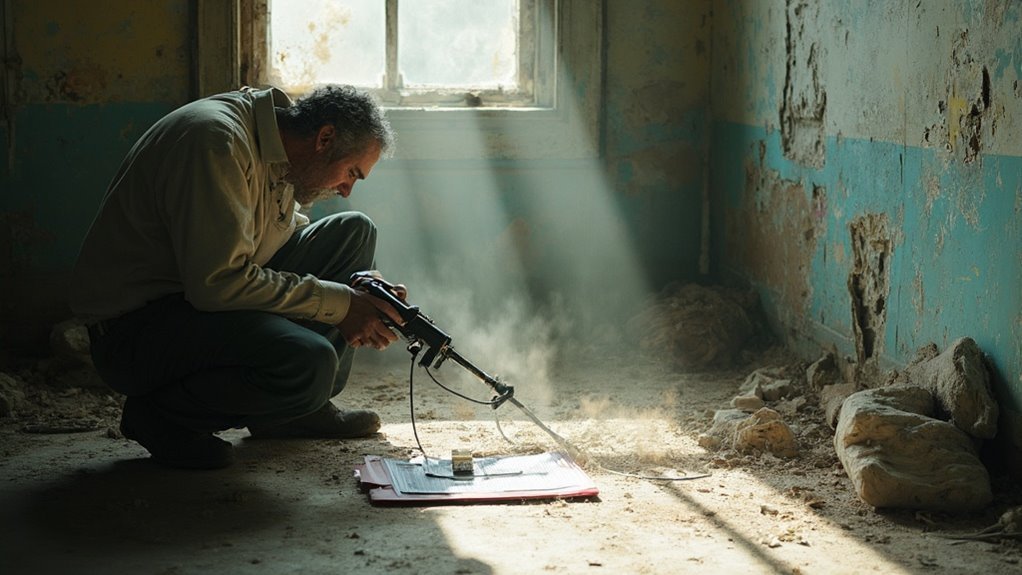
Identifying asbestos in properties requires a careful examination of various materials and locations where asbestos is commonly found. To help you recognize potential asbestos signs, consider these common areas:
- Vinyl floor tiles, especially 9×9 inch tiles.
- Textured or popcorn ceiling tiles.
- Insulation materials, including attic or wall insulation.
- Older roofing shingles and siding.
When inspecting for asbestos, look for visual indicators such as a fibrous appearance and specific color cues. Asbestos fibers may be blue (crocidolite), brown (amosite), or white (chrysotile), though they can be too small to see without specialized equipment. Damaged materials often reveal frayed edges that resemble fizzy fabric, which can signal the presence of asbestos.
Keep in mind that visual inspections alone are not conclusive. It's critical to engage professional testing to accurately identify and confirm asbestos presence. Trained experts use sophisticated methods and equipment to safely collect samples and provide reliable analysis. By understanding these key aspects, you can better assess the risk of asbestos in your property and take the necessary steps for safety and compliance.
Health Risks of Asbestos Exposure
Understanding the potential presence of asbestos in your property is only the first step; recognizing the serious health risks associated with asbestos exposure is just as important. Asbestos health risks manifest primarily through various cancers and lung diseases. Inhalation of asbestos fibers can lead to lung cancer, a condition that develops over time as the fibers damage lung tissues. Mesothelioma, a rare cancer affecting the lining of the body cavity, is directly linked to asbestos exposure. Furthermore, asbestosis, characterized by lung scarring and inflammation, greatly impairs lung and heart function.
Exposure symptoms often begin with persistent coughing and shortness of breath, which can be easily misattributed to less severe conditions. The latency period for asbestos-related diseases can extend from 15 to 50 years, making early detection challenging. Long-term exposure, especially in conjunction with tobacco use, dramatically increases the risk of developing lung cancer. Nonmalignant conditions like pleural plaques and thickening likewise arise from exposure, contributing to respiratory issues. Given these severe health implications, understanding the risks associated with asbestos is vital for safeguarding your well-being.
Next Steps for Property Owners
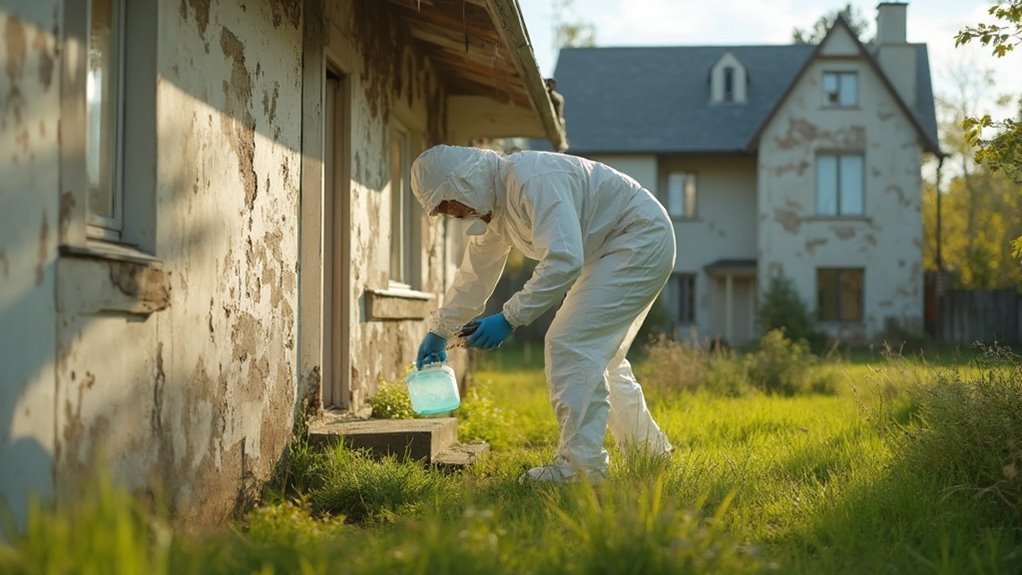
As a property owner, taking decisive action after confirming the presence of asbestos is vital for safety and compliance. You need to follow these important steps to guarantee you meet asbestos regulations:
- Hire Certified Professionals: Engage licensed asbestos abatement contractors for removal or encapsulation.
- Conduct Proper Testing: Utilize accredited laboratories for thorough analysis of collected samples.
- Keep Records: Maintain all asbestos survey reports for future renovations or demolitions.
- Guarantee Safe Disposal: Work with registered asbestos disposal firms for waste management.
Failing to comply with asbestos regulations can lead to significant fines and legal repercussions. It's imperative to have a certified asbestos investigator perform a detailed survey to identify any asbestos-containing materials (ACMs) in your property. Once identified, you must act swiftly to either remove or encapsulate these materials, making sure you hire licensed contractors for the job. Furthermore, regular inspections may be necessary for properties with known ACMs, and you must follow all recommendations outlined in the asbestos survey report. By adhering to these steps, you safeguard your property, comply with regulations, and protect the health of all occupants.
Frequently Asked Questions
How Long Does the Asbestos Testing Process Typically Take?
The asbestos testing timeline varies, typically taking a few hours for inspection and one to two weeks for lab results. You'll follow testing procedure steps including visual inspection, sample collection, and lab analysis for accurate results.
What Should I Do if Asbestos Is Found?
If asbestos lurks like a hidden danger, act swiftly. Prioritize asbestos removal, develop a meticulous abatement plan, hire certified professionals, and guarantee safety protocols are in place to mitigate health risks for all occupants.
Are DIY Asbestos Testing Kits Reliable?
DIY kits often raise accuracy concerns because of their inability to detect low asbestos levels reliably. Their limitations can lead to false negatives or positives, making professional testing crucial for accurate and safe asbestos identification.
How Much Does Professional Asbestos Testing Cost?
Professional asbestos testing costs vary, typically ranging from $231 to $778, influenced by property size, location, and sample type. Engaging professional services guarantees accurate results while adhering to safety regulations and minimizing health risks.
Will My Insurance Cover Asbestos Testing and Removal?
"An ounce of prevention is worth a pound of cure." Your insurance policy might cover asbestos testing and removal, but check your coverage limits. Coverage often depends on whether damage stems from a covered peril.
